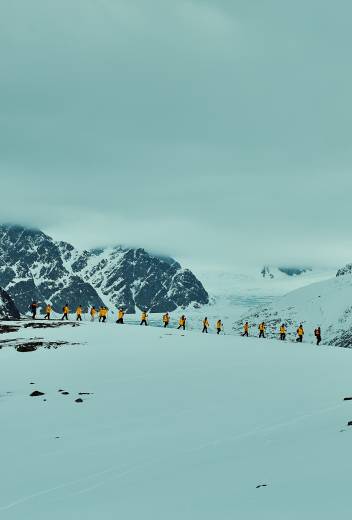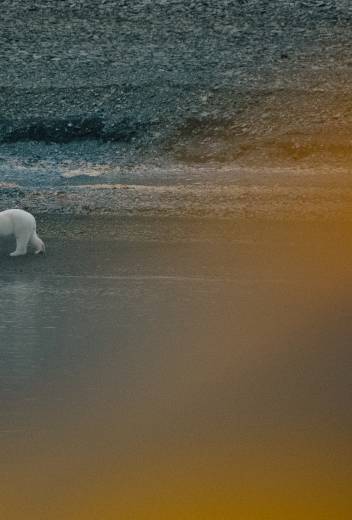Imagine standing outdoors in the quiet of an Arctic night, your eyes peeled to the polar sky, watching in astonishment as an explosion of multicolored lights break out in a dramatic dance across the night sky, swathes of bright colors swooping majestically above the darkened landscape as if choreographed by some unseen maestro. Curvy waves of green mixed with curls of purple flickering above the northern terrain. That was my first experience of the natural phenomenon of the Northern Lights.
The Aurora Borealis, the scientific name for the Northern Lights, results when charged particles from the sun become trapped in the Earth’s magnetic field, creating one of the most stunning displays of greens, purples, reds and yellows against the dark backdrop of the nighttime sky.

Remote Arctic regions are ideal places to see the Northern Lights, as
experienced by this guest on a Quark Expedition vessel in East Greenland. Photo: Acacia Johnson
The Northern Lights I witnessed on that Arctic night remain will remain imprinted in my visual memory bank forever. At times, the Northern Lights defy description because the shapes and colors aren’t always the same. As NASA astronomer Sten Odenwald explains in his book The 23rd Cycle: Learning to Live With a Stormy Star: “Displays [of the Northern Lights] may take many forms, including rippling curtains, pulsating globs, traveling pulses, or steady glows. Altitude affects the colors. Blue violet/reds occur below 60 miles (100 km), with bright green strongest between 60-150 miles (100-240 km). Above 150 miles (240 km) ruby reds appear.”
The Mythology and Lore of the Northern Lights
However the Northern Lights manifest themselves, witnessing the phenomenon tops the bucket lists of travelers from around the globe, fuelled no doubt by the rich mythology that has developed over two millennia.
Many Inuit, the Indigenous peoples of the Arctic, long ago accepted that the Northern Lights were spirits of the dead playing a soccer-like game with a walrus skull. In Norse mythology, legend suggests the Northern Lights were the glow from the armour and shields of the mythic Valkyrie, powerful female warriors. And there was a time when Icelanders firmly believed that expectant mothers would experience a difficult delivery—and possibly give birth to a cross-eyed baby—were she to look at the Northern Lights while pregnant.
There’s also been significant debate—still unresolved in the scientific community—whether one can “hear” the Northern Lights. Danish explorer Knud Rassmussen, as mentioned in “Of Legends and Folklore: Greenland’s Northern Lights,” reported in the 1930s that the Northern Lights made a “whistling, rustling, crackling sound.”
Consequently, the desire to witness the Northern Lights has been cemented in our collective bucket list.
How to See the Northern Lights
Multi-day polar expeditions in the Arctic boost a traveler’s chances of witnessing the full splendor
of the Northern Lights. Photo: Acacia Johnson
The Northern Lights can be unpredictable. There are legions of stories from travelers who’ve booked a one-night Northern Lights tour while on holiday only to be disappointed when the “lights just didn’t show up.” The Northern Lights, like any element of nature, don’t necessarily perform on demand. Various factors are required, such as a clear cloudless night, minimal light pollution away from large human settlements and, of course, an experienced guide who’s proven they know how to see the Northern Lights.
A one-time Northern Lights outing only gives you one chance. By booking a multi-night voyage in the Arctic, you could have as many chances as the length of your voyage, be it seven or 14 nights. Imagine what it would be like to see the Northern Lights on multiple evenings, not to mention the chance to see, by daylight, icebergs, glaciers, rugged tundra and incredible wildlife such as polar bears, whales and walruses.
Where is the best place to see the Northern Lights?
The Northern Lights viewed on an Arctic expedition in Greenland: Few experiences rival the magic of witnessing the incredible
multicoloured light display that dances across the night sky. Photo: Acacia Johnson
If you’re wondering how to see the Northern Lights, the first step is to plan a trip to the northern latitudes. The best places in the world to see the Northern Lights are usually closer to the Arctic Circle, including Alaska, Canada, Iceland, Greenland, Norway, Sweden and Finland. The farther north you travel the greater your chances of seeing an aural display. And within these destinations, the best places are those without light pollution, so it wouldn’t be advisable to expect an amazing Northern Lights experience close to a large settlement with lots of human-made light.
Greenland, for instance, is ideal for those bucket-listers on a quest to see the Northern Lights. There is little artificial light compared to other parts of the world, and visitors can encounter clear sky conditions from September to the beginning of April. According to Space Tourism Guide, Kangerlussuaq, in eastern Greenland, “is one of the best places in the world to see the Northern Lights.” The small town is located on a fjord right along the Arctic Circle and is blessed with an annual average of 300 clear night skies each year making it ideal to visit, especially between October and April. Kangerlussuaqis included in Quark Expeditions’ Gems of West Greenland: Fjords, Icebergs, and Culture itinerary.
Another Greenland location where visitors have witnessed wonderful displays of the Northern lights is the small settlement of Ittoqqortoormiit (population: 345), which, of course, is not only remote with minimal artificial light but is accessible on a multi-night polar expedition. Ittoqqortoormiit is a highlight on Quark Expeditions’ 14-day Under the Northern Lights: Exploring Iceland & East Greenland voyage.
When is the Best Time to See the Northern Lights?
The best time to see the Northern Lights depends not just on when the lights are most visible—but also when it’s suitable to travel to those locations favorable to the lights. September and October are among the best times to see the Northern Lights as travelers during those months can avoid the extreme cold of an Arctic winter. In addition, as reported by NASA, enthusiasts have greater chances of seeing the Northern Lights during an Equinox, such as the Fall Equinox (September), because of the planet’s position and angle in relation to the sun.
From the Deck of a Polar Ship
As polar expedition guide and photographer Acacia Johnson shared in her blog: “The Celestial Wonders of the Northern Lights,” seeing the Northern Lights while on an expedition vessel has been one of her most memorable polar moments. Experienced expedition guides, who know how to see the Northern Lights, carefully monitor conditions of the sky, alert passengers in the small hours of the night whenever the Northern Lights begin their magical nightly dance.
As Johnson reflects in her blog: “It was then, as we were drifting to sleep after a long and joyous day of hiking, that we first saw them. The gentle voice of our expedition leader eased us from our dreams, confirming what we’d all been hoping for: the Northern Lights were visible, at last, above our ship. On the top deck of the vessel, faint patterns of green wavered and danced across the sky…rushes of light and color, energy and motion, softly ribboning from one end of the sky to the next. Dancing, soaring clean arcs overhead, to land on the other side, above the mountains, in a splash of stars and nautical twilight.”
Seeing the Northern Lights for the first time leaves the traveler with a profound sense of awe. Much like observing a pod of whales in the Arctic waters or watching a polar bear sauntering across the ice-covered landscape, seeing the Northern Lights is one of those polar moments that borders on the otherworldly. It’s one more reason to venture to the Arctic.










